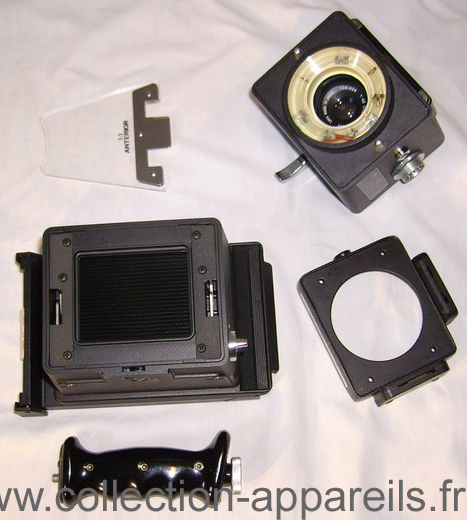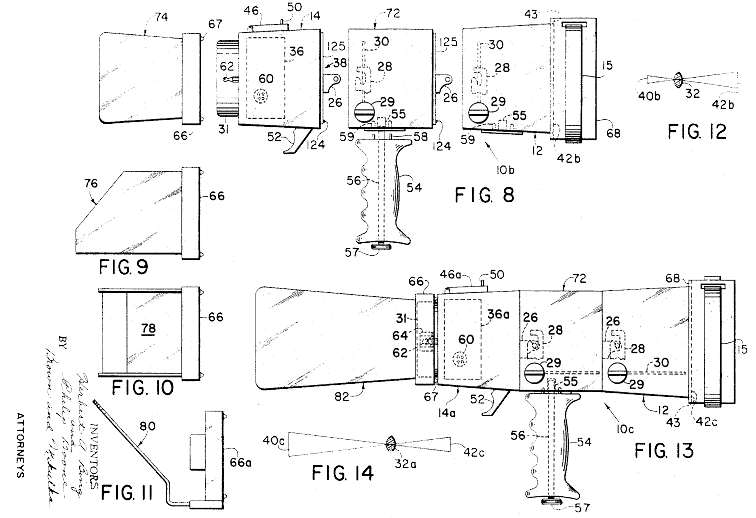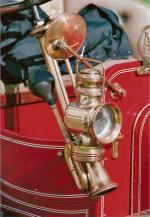|
Polaroid CU5 |
Manufactured or assembled in from 1964 to (After) 1978.
Index of rarity in France: Rare (among non-specialized garage sales)
Inventory number: 10251
See the complete technical specifications
Chronology of cameras Polaroid
The successors to the Swinger, the Colorpack cameras make up a vast family of cameras that use pack films. The entire range of cameras is built around the Pack 80 and Pack 100.
The use of pack films represents a significant advancement for users. Loading is greatly simplified compared to roll films. One needs to open the back of the camera, remove the empty pack, insert a new one by sliding it under the film shield. White tabs must emerge from the pack before closing the back of the camera, which is then secured in place with a large clip.
Since the two batteries are not included in the pack, they need to be changed at least once a year. They are housed in a removable compartment located in the camera's chamber.
After taking a shot, a sequence of actions needs to be followed to retrieve the photo, as the development is done externally. This process takes around 30 seconds for black and white films and 1 minute for color films. The prints do not need to be lacquered for proper preservation. The development time must be meticulously adhered to, and some models feature a timer to assist the user. Once the time has passed, the negative must be separated from the print. Thus, while there is indeed progress in loading, the development process still requires attention. It will take the SX-70 films to truly simplify this process.
In France :
| Years | Pack 80 (8,8 x 8,5 cm) | Pack 100 (8,5 x 10,5 cm) |
Sale Price (francs) | ||||||
| 87 (N&B) |
88 |
105 (Neg/Pos) | 107 (N&B) |
108 | |||||
| 3200 ASA | 75 ASA | 3200 ASA | 75 ASA | ||||||
| Model 3000 |  |
1969-70 | Yes | 128 (1970) | Fixfocus, meniscus | ||||
| Colorpack II | 1969-71 | Yes | Yes | 182 (1970) | Triplet. Focusing | ||||
| Colorpack III | 1970-74 | Yes | Yes | 233 (1970) | like Colorpack II, with timer | ||||
| Colorpack 80 |
 |
1971-76 | Yes | Yes | 171 (1973) | ||||
| Colopack 82 |  |
1972-76 | Yes | Yes | 205 (1973) | like Colorpack 80, with timer | |||
| Colorpack 88 |  |
1974-76 | Yes | 170 (1975) | like Colorpack 80 | ||||
| Colorpack 100 |  |
1973-76 | Yes | Yes | 276 (1975) | ||||
| Zip |  |
1972-76 | Yes | <100 (1972) | Fixfocus, basic | ||||
| Big Shot |  |
1972-74 | Yes | 180 (1972) | |||||
| Starting from 1976, the lineup undergoes a name change, and the cameras are renamed as the EE series. | |||||||||
| EE22 |  |
1976-78 | Yes | 125 (1976) | Fixfocus | ||||
| EE33 |  |
1976-78 | Yes | 152 (1976) | |||||
| EE44 | 1976-78 | Yes | Yes | 208 (1976) | |||||
| EE55 |  |
1976-78 | Yes | Yes | Yes | 235 (1976) | |||
| EE66 | 1976-78 | Yes | Yes | Yes | Yes | Yes | 287 (1976) | ||
| EE100 |  |
1977-80 | Yes | Yes | Yes | Yes | Yes | 427 (1977) | |
| In 1978, another name change occurs. The lineup becomes more limited, signaling the approaching end of the Colorpack era. | |||||||||
| Instant 10 | 1978-80 | Yes | 149 (1978) | ||||||
| Instant 20 | 1978-80 | Yes | Yes | 153 (1979) | |||||
| Instant 30 |  |
1978-80 | Yes | Yes | Yes | Yes | Yes | 199 (1978) | |
Colorpack cameras are usually designed to accommodate a Flash-Cube. A Fresnel lens is sometimes used as a diffuser.
__________This model is uncommon because of its specialized use. It is intended for photography in the medical field (dentists, doctors) or industrial (inventories, small components, reproduction of documents, etc.)
The camera body is compatible with two interchangeable lenses with built-in trigger (127 mm and Tominon 4.5/75 mm) and a back for Pack 100. The shutter has 10 speeds (1/125 to 1s, B, T) and 8 openings (from 4 to 45). The lens settings are accessible through a small hatch on the top of the camera.
An electronic flash is integrated around each lens.
Many accessories can be added, especially to grow (multiply ratio). They are inserted between the body and the lens to increase the optical ratio (up to two ratio multipliers at a time).
Other accessories also include a focusless rangefinder (involving movement around the subject). Covers, filters and dental mirrors attach to specific mounts that fit on the front of the lens.
The camera itself does not have a darken/lighten setting, this is on the flash power supply. Flash output can be increased or decreased to compensate for exposure.


Ce modèle a fait l'objet d'un brevet (3295425). Il a été déposé le 30 décembre 1964, avec comme inventeurs Herbert A. Bing et Philip Boone.

La description du brevet mentionne qu'il s'agit d'un appareil photo capable de produire rapidement des épreuves noir et blanc, ou couleurs, dans le domaine de la macro-photographie.
Interesting links or bibliography :
Add a link or element of bibliography, a picture taken with this camera, a picture of box or an ads about this camera
Your photos taken with the same camera:
Cameras from Ebay France (Polaroid) (Uploaded each 3 hours)








